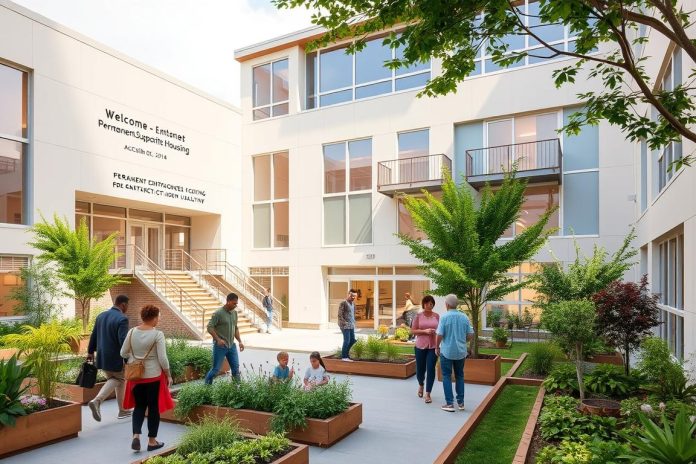Imagine getting the keys to your new home after months of looking. That feeling of security, knowing you have a place to sleep every night. It’s vital for hoping for a better future. This can be real with housing help and low-cost housing plans. These help people find their place in the tough housing market. Through rent aid or government housing projects, these efforts save lives. They often use the Housing First method, which keeps 98% of people in homes for a year in Permanent Supportive Housing programs1. These programs are the first step toward affordable and stable living.
When you discover the resources out there, remember these aren’t just statistics. They make a real difference in people’s lives. For some, it’s Rapid re-housing programs that quickly end homelessness. They often find homes in just two months and keep 75% to 91% of people housed a year later1. For others, it’s about being independent and in control with Housing First programs. Here, most get the extra help they need1.
Thinking about joining these programs? They do more than just save you money. Housing First, for example, cuts down emergency service costs. It saves about $31,545 per person over two years compared to usual methods1. This money helps the community, creating a support system that benefits all. Housing is more than a building; it’s crucial for community well-being and personal success.
Key Takeaways
- Housing assistance provides a fundamental step towards long-term stability and quality of life.
- Affordable housing programs alleviate financial burdens and cater to those most in need.
- Rapid re-housing programs significantly cut down the time it takes to move from homelessness to a permanent home.
- Government housing programs not only benefit individuals but also contribute to broader societal economic efficiency.
- Embracing Housing First strategies paves the way for high retention rates and autonomy for clients.
- The integration of housing programs into your life can be transformative, offering a path to secure housing and a brighter future.
Understanding Housing First: A Game-Changer in Housing Assistance
Housing First has changed the way we tackle homelessness. It gives people homes right away, without conditions. This approach doesn’t just provide housing. It also offers necessary services designed for each person’s needs.
Core Principles of Housing First
Housing First believes everyone deserves a home. It provides long-term homes and quick housing help without demanding treatment or sobriety first. This freedom supports recovery and helps people become part of the community. It helps them stay in their homes for a long time.
Success Rates of Permanent Supportive Housing and Rapid Re-Housing
The success of Housing First is proven by data. Permanent supportive housing keeps 98% of people in their homes for a year, helping those with big needs2. Rapid re-housing helps people leave homelessness faster, focusing on various needs and reducing unstable times3.
These efforts have made lives better and given people a sense of belonging and recovery. Stories of moving from the streets to stability show how right housing and support can change lives.
Financial Savings through Housing First Programs
Housing First saves money, too. Places that use it spend less on emergency services like shelters and hospitals. This saves public funds, millions of dollars4. Housing vouchers are key, making it cheaper for the public and helping more people get homes sooner.
A recent $5 million grant helps keep people in their homes and integrated in their communities2.
Using Housing First to fight homelessness is crucial. This insightful article shows it’s about more than a roof. It’s about stable, dignified lives.
We need to rethink our strategies and learn from success stories. This way, we can not only end homelessness but also improve the well-being of our society. The move from the streets to a stable home is about feeling secure and confident again.
Housing Assistance Programs Administered by HUD
If you need a stable and affordable home, HUD has many options. They offer help with renting and buying homes. HUD supports around 970,000 households in public housing, managed by over 3,300 agencies56. You might get HUD help if your income is below 80% of your area’s median. There are special programs for those who earn 50% or less5.
HUD’s financial rules are based on fairness. They consider your yearly income and deductions5. Programs like Section 8 help low-income families, the elderly, and people with disabilities. This year, Section 8 will help over 3 million households7. HUD’s Section 811 program offers housing and services for adults with disabilities who earn very little6.
HUD also fights for fair housing. They work hard to stop housing discrimination and ensure everyone has equal housing opportunities. If you’re looking for reliable housing agencies, want to know your rights, or need help with housing programs, HUD can guide you. They make it easier to find and afford a good place to live.
FAQ
What types of housing assistance programs are available for low-income individuals?
How does Housing First differ from other housing assistance approaches?
What are the core principles of Housing First?
Can you share some success rates of Permanent Supportive Housing (PSH) and Rapid Re-Housing?
What financial savings do Housing First programs typically achieve?
How does HUD support individuals and families in need of affordable housing?
What should I do if I suspect housing discrimination?
How do I apply for a Section 8 voucher, and what does it cover?
Source Links
- Housing First – https://endhomelessness.org/resource/housing-first/
- Housing Multnomah Now pilot initiative houses 311 households – JOHS – https://johs.us/2024/07/25/housing-multnomah-now-houses-311-households/
- The Pitfalls of Housing First: A Better Path to Solving Homelessness – True Charity – https://www.truecharity.us/the-pitfalls-of-housing-first-a-better-path-to-solving-homelessness/
- Housing First won’t solve the homeless crisis – https://www.citynewsokc.com/community/housing-first-wont-solve-the-homeless-crisis/article_7d616cfa-514f-11ef-95ff-27039bcdce1d.html
- HUD’s Public Housing Program – https://www.hud.gov/topics/rental_assistance/phprog
- Multifamily Housing – Program Description – https://www.hud.gov/program_offices/housing/mfh/progdesc/disab811
- Q and A about HUD – https://www.hud.gov/about/qaintro

